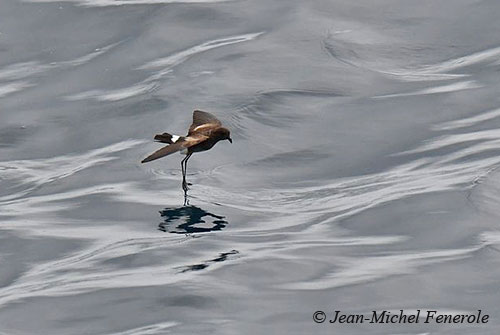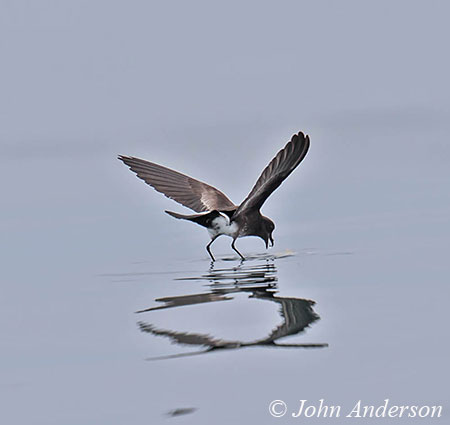
Fr: Océanite d'Elliot
Ang: Elliot's Storm-Petrel - White-vented Storm-Petrel
All: Elliotsturmschwalbe
Esp: Paíño de Elliot
Ita: Uccello delle tempeste culbianco
Nd: Sierlijk Stormvogeltje
Sd: elliotstormsvala
Photographers:
John Anderson
John Anderson Photo Galleries
Jean Michel Fenerole
Photos d’Oiseaux du monde
William Price
PBase-tereksandpiper & Flickr William Price
Text by Nicole Bouglouan
SOURCES:
HANDBOOK OF THE BIRDS OF THE WORLD vol 1 by Josep del Hoyo-Andrew Elliot-Jordi Sargatal - Lynx Edicions - ISBN: 8487334105
OISEAUX DE MER – Guide d’identification de Peter Harrison – Editions Broquet (Canada) – ISBN-10 : 2890004090 – ISBN-13 : 978-2890004092
SORA - DISCOVERY OF A BREEDING COLONY OF ELLIOT'S STORMPETRELS (OCEANITES GRACILIS, HYDROBATIDAE) IN CHILE
To save the tiny seabird, scientists are venturing to its secret home in the Atacama Desert—and sticking their noses into a lot of stinky holes in the ground.
Wikipedia, the free encyclopaedia
Elliot's Storm-Petrel or White-vented Storm-Petrel
Oceanites gracilis
Procellariiformes Order – Oceanitidae Family
INTRODUCTION:
The Elliot's Storm-Petrel or White-vented Storm-Petrel is a seabird of the Humboldt Current off Ecuador, Peru and Chile. Two subspecies share the range, but the subspecies O.g. galapagoensis is mainly found in the waters around the Galapagos Islands.
The species is marine and pelagic, often over cool waters and fairly near land. The breeding range is poorly known, but several observations allow to describe some of them, especially in the Atacama Desert. It nests in cavities in various types of soils and in rock crevices.
Like other storm-petrels, the Elliot's Storm-Petrel feeds on small fish and planktonic crustaceans, and also scavenges on dead cetaceans. It typically feeds on the wing by pattering over the sea surface and occasionally dipping. It also follows the ships.
The status of the Elliot's Storm-Petrel is poorly known. However, it is affected by invasive rats. Human activities and light pollution are still a problem on the breeding sites, and commercial fishing may have a negative impact by reducing the food resources.
The Elliot's Storm-Petrel is not globally threatened at the moment, but more information is needed.

DESCRIPTION OF THE BIRD:
Biometrics:
Length: 15-16 cm
Wingspan: 36-40 cm
Weight: 14-17 g
The Elliot's Storm-Petrel is a small Oceanitidae.
Head and upperparts are blackish brown to sooty black, but the head is less brownish. The white uppertail-coverts contrast strongly with the blackish rump and the square-ended tail. On the uppertail, the two outermost rectrices show white shafts at base.
The upperwing is blackish brown with less brownish flight-feathers. The outer and central greater coverts are paler greyish.
In worn plumage, the dark areas are tinged rusty, whereas the pale upperwing panel is larger and more contrasting.
The underparts are dark like the upperparts, but a conspicuous white area extends from the uppertail-coverts to the rear flanks and lateral undertail-coverts. The dark thighs separate this area from the white central belly and vent.
The underwing is dark, but greater and median coverts and most of the primary coverts have whitish tips forming sometimes a silvery band.
The head is entirely dark.
The bill is black.
The eyes are dark brown.
Legs and feet are black. The webs are yellow with black edges. In flight, the long legs project beyond the tip of the tail.
Male and female are similar in plumage, but the female has longer wings than male.
The juvenile resembles adults.
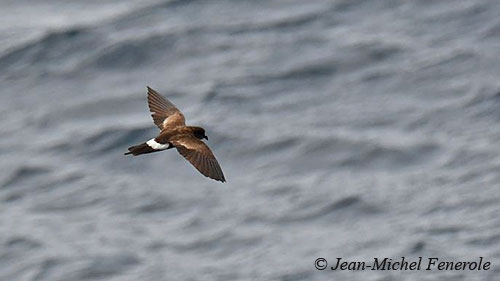
SUBSPECIES AND RANGE:
The Elliot's Storm-Petrel has two subspecies.
O.g. gracilis (described above) is found in E Pacific Ocean, usually in the cool waters of the Humboldt Current, from Ecuador, S to Central Chile. The breeding range is poorly known and only reported at Chungungo Islet off Chile.
But two new inland breeding sites were discovered in Pampa Hermosa and Pampa del Indio Muerto, in the Atacama Desert stretching for 960 km through N Chile.
O.g. galapagoensis occurs in waters around the Galapagos Islands where it presumably breeds and is present year-round.
This race is average larger with more white on belly.
HABITAT:
The Elliot's Storm-Petrel is marine and pelagic, often in cool waters near land.
The breeding sites are poorly known, but the known sites are in different soils such as gypsum formation and salt flats. These sites are in the middle of the Atacama Desert, up to 70 km from the shoreline.
In Chungungo Islet, the nests are inside rock crevices or below rocks, some of them covered by dense bushes.
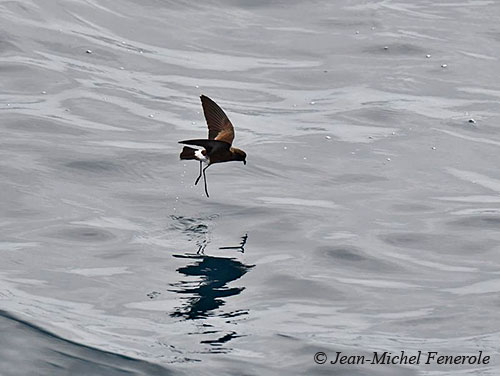
CALLS AND SONGS: SOUNDS BY XENO-CANTO
The Elliot's Storm-Petrel gives some short, repeated sharp calls when on land, but it is silent at sea, except when several birds are foraging together and fighting for prey. The territorial call is a harmonic sound, a series of four high-pitched notes.
The incubating adult produces short calls from inside the burrow, when the chick begs for food. The chick’s call is a simplification of the adult’s call with fewer notes, but similar in tempo and rhythm, rising and falling regularly.
BEHAVIOUR IN THE WILD:
The Elliot's Storm-Petrel’s diet is very little known. Some observations of this species feeding on dead cetaceans are reported. Small fish and planktonic crustaceans are also probably taken.
The species is pelagic but it usually forages and feeds close to the shores. However, it often follows the ships.
They feed by fluttering and pattering on the water while the wings are raised. They flutter over the sea surface, appearing to “walk-on-water” in search of food and scraps of fish killed by predators.
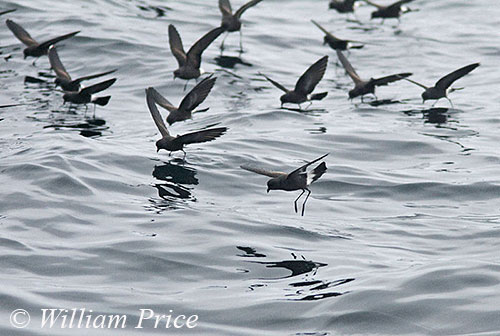
The breeding behaviour is poorly known. Usually, the storm-petrels often engage in aerial chases as part of the courtship displays. They fly fast in circles above the nesting sites, very close to each other. These displays are accompanied by frequent loud calls. During these flights performed in almost total darkness, the white rump is conspicuous and exposed.
The Elliot's Storm-Petrel nests in cavities of 40-200 cm long, in salt, gypsum or rocks.
They are colonial breeders. Both parents share the nesting duties. The birds come to the breeding sites with the darkness.
The Elliot's Storm-Petrel disperses only inside the Humboldt Current, along the West coast of South America.
The subspecies O.g. galapagoensis is a common resident in the Galapagos Islands.
The storm-petrels are small and light, and they are weak fliers in bad weather. Large numbers may be displaced and driven ashore by strong winds. However, the Elliot's Storm-Petrel is very agile while foraging over the sea surface.
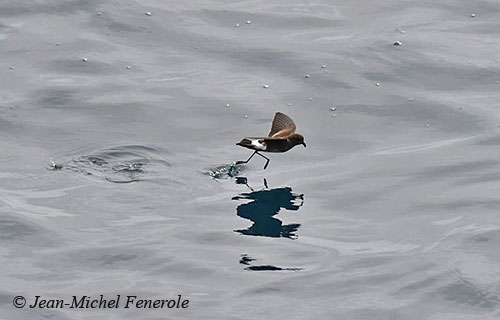
REPRODUCTION OF THIS SPECIES:
The breeding season in Galapagos Islands is suspected to occur between April and October, with a post-nuptial moulting in November-January.
The nominate race seems to have two breeding peaks, with one in austral winter and another in austral summer.
The Elliot's Storm-Petrel nests in cavities formed by salt, gypsum or rocks, without addition of nesting material. The entrance is narrow, usually less than 15 cm, whereas the depth is variable, depending on the soil (between 40 and 200 cm).
The female lays a single white egg with pink spots. Both parents share the incubation in stints of 2-8 days, depending on weather and distance to the feeding areas. The duration of the incubation is unknown.
At hatching, the chick has thick, greyish down, often paler on the underparts. It is fed at night on partly-digested paste of small fish and crustaceans.
The development of the chick at nest lasts 7-8 weeks. Then, it flies directly out to the sea where it will live for 2-4 years.
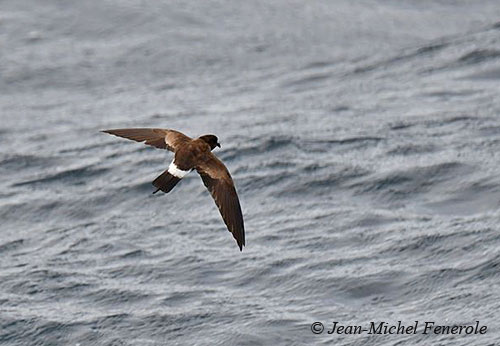
PROTECTION / THREATS / STATUS:
The Elliot's Storm-Petrel is threatened by light pollution in Chungungo Islet, from cities in the Coquimbo region, but also by the future development of a mine and its port in the area (Domingo).
The introduced rats are also a potential threat.
The commercial fishing may have a negative impact on this species by reducing the food resources.
The population was roughly estimated by Brooke in 2004, and the numbers were suspected to exceed 30,000 individuals.
But more information is needed, with the search of the breeding colonies from Chile N to the Galapagos Islands, to evaluate the threats.
The Elliot's Storm-Petrel is currently considered Data Deficient, with largely unknown population trends.
